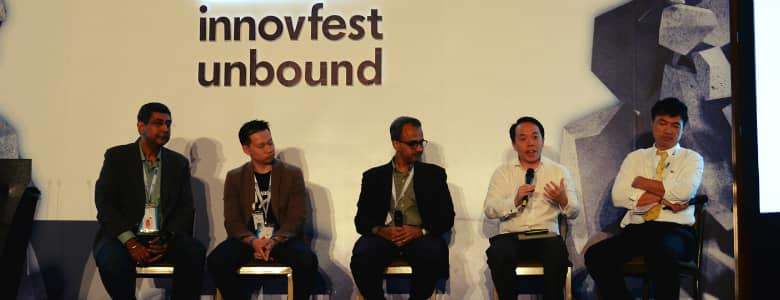Demystifying AI and Big Data

Artificial intelligence (AI), deep learning and big data analytics are the tech world’s current buzzwords.
The power and promise of these methods and technologies — and the hype surrounding them — has generated a huge wave of excitement, and many in academia and industry are eager to apply them in their respective fields.
But applying such approaches willy-nilly is not the answer to the world’s problems, said experts on the ‘Demystifying Data Science and Deep Learning’ panel at the Innovfest Unbound conference that took place on 4 May.
Instead, careful thought should be given to how these methods can be used for maximum real-world impact.
The panel comprised Dr Daniel Lim, Data Scientist at the Government Technology Agency of Singapore (GovTech); Mr Tho Lye King, IBM Watson Lead for ASEAN; Dr Ettisan Karuppiah, Director (Developers Ecosystem) at NVIDIA Singapore; and Professor Ooi Beng Chin, Distinguished Professor of Computer Science at the National University of Singapore (NUS).
It was moderated by Mr Jawahar Kanjilal, Founder of mobile sales cloud-based platform TeamStreamz.
Use, don’t abuse the technology
No one doubts the transformative potential of big data and AI.
At NUS, researchers are putting machine learning approaches to work in a wide variety of applications, including predicting hospital readmissions, food image recognition and malware detection, said Professor Ooi.
The IBM Watson supercomputer runs on powerful AI that blurs the boundaries between programmable and cognitive systems, said Mr Tho, thus allowing users to gain valuable insights from unstructured, complex data.
NVIDIA, a pioneer in graphics processing units (GPUs), uses the technology to accelerate big data analysis and deep learning approaches, explained Dr Karuppiah.
And over at GovTech, data scientists apply big data to public policy, addressing issues as diverse as train breakdowns, customer segmentation for public services and topic modelling of customer feedback, said Dr Lim.
But the power of such approaches should not be abused, cautioned Professor Ooi.
“We do not need AI in every process or programme — that’s overkill,” he said. “AI cannot solve all problems; quite often you need a human to step in.”
What’s the problem?
So how does one judge if the time, effort and money put into implementing big data- and AI-based approaches will make a meaningful difference to the situation at hand?
For Dr Lim, an important criterion is the potential for real-world impact.
“The hypothetical question we ask ourselves is: assuming we gave you the best analysis possible, how would it change the way you design your policy or run your operations?” he said.
“The outcome cannot be just a report that you read and file away.”
In addition, such projects also need the support of the upper echelons. “We need to get buy-in at a senior enough level, so that the senior person is later able to make changes to policy or operations, and can also grant you access to data,” added Dr Lim.
For Dr Karuppiah, figuring out exactly which part of a complex problem is best addressed by deep learning approaches is key. “You need to know your workflow, decompose it to the level that lets you determine which problem can be addressed by deep learning, and then solve that,” he said.
“The tools and software are already there; it is finding this bottleneck or pain point that is the most difficult.”
Agreeing, Mr Tho from IBM said that the company espouses design thinking for solving complex problems.
“We flush out the actual problem statement, run through the logic, and then look for methods to solve it.”
Building a top-notch team
Problem-solving in the fields of big data and AI also requires a first-rate, multidisciplinary team of individuals, agreed the panel.
In Dr Karuppiah’s opinion, teams need subject matter experts to deal with the specific issue at hand; coders to work with these experts to analyse the data and implement a solution; and finally, communicators to translate the outcomes to data owners and consumers.
“You need these three capabilities for your team to function in a systematic manner, so that you can solve problems in timely fashion,” he explained.
How does one begin to assemble this A-team? Talented people will go where there are challenging, varied problems for them to wrap their heads around, said Dr Lim.
“We need to feed people with interesting problems. If you put a data scientist in a really small industry, he or she might have one interesting project to do and that’s it. That’s not really a viable career path,” he said.
GovTech’s data scientists, he added, are rotated across different government ministries and agencies, thus giving them a constant stream of problems to think about.
Dr Lim also had some advice for those keen to break into the field of data science.
“While you do need some foundation in statistics and computer science, most learning is on the job,” he said. “It’s more than just understanding the models; it’s how you apply them to different domains and across different use cases. For that, I think there is no substitute for actual practical experience.”
Some members of GovTech’s team, shared Dr Lim, had no prior experience with data science, but picked it up on the job and through online courses.
“It can definitely be done, but you must have the drive and the desire to learn,” he concluded.
https://www.tech.gov.sg/media/technews/demystifying-ai-and-big-data
